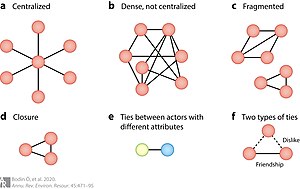
In a social network analysis (as in blockmodeling), a positive or a negative 'friendship' can be established between two nodes in a network; this results in a signed network. As social interaction between people can be positive or negative, so can be links between the nodes (representing persons). [1]
When a positive or a negative value is attributed on the relationship between the two nodes, it is called a user evaluation. [2] In social groups, people can like or dislike, respect or disrespect other people in their social groups. [3]
The quality of such connections can be further analysed, as a positive connections can have a positive influence on the whole network (one person on social group or society in general) and vice versa. [4]
When network connections are not evaluated between the nodes (e.g., all connections are regarded as positive - as they exist), then such a network is defined as an unsigned network. [5]
For intrinsically dense unsigned networks where link weights can be observed, the underlying networks may actually be signed networks. The underlying signed network backbones can be extracted using significance filter and vigor filter [6] using open-source software packages in R [7] and Python. [8]
References
- ^ Geeksforgeeks.org - Signed Networks in Social Networks
- ^ Raj, P. M. K.; Mohan, A.; Srinivasa, K. G. (2018). "Signed Networks". Practical Social Network Analysis with Python. Computer Communications and Networks. Springer. doi: 10.1007/978-3-319-96746-2_7. ISBN 978-3-319-96746-2.
- ^ Doreian, Patrick; Mrvar, Andrej (2009). "Partitioning signed social networks". Social Networks. 31 (1): 1–11. doi: 10.1016/j.socnet.2008.08.001.
- ^ Esmailian, Pouya; Jalili, Mahdi (2015). "Community Detection in Signed Networks: the Role of Negative ties in Different Scales". Scientific Reports. 5 (14339): 14339. Bibcode: 2015NatSR...514339E. doi: 10.1038/srep14339. PMC 4585820. PMID 26395815.
- ^ Peter Langfelder - Signed or unsigned: which network type is preferable?
- ^ Gursoy, Furkan; Badur, Bertan (2021-09-18). "Extracting the signed backbone of intrinsically dense weighted networks". Journal of Complex Networks. 9 (5). arXiv: 2012.05216. doi: 10.1093/comnet/cnab019. ISSN 2051-1310.
- ^ Gursoy, Furkan (2021-06-01), R Package ‘signed.backbones’, retrieved 2023-08-09
- ^ Gürsoy, Furkan, signed_backbones: Python package for extracting signed backbones of intrinsically dense weighted networks., retrieved 2023-08-09
See also

In a social network analysis (as in blockmodeling), a positive or a negative 'friendship' can be established between two nodes in a network; this results in a signed network. As social interaction between people can be positive or negative, so can be links between the nodes (representing persons). [1]
When a positive or a negative value is attributed on the relationship between the two nodes, it is called a user evaluation. [2] In social groups, people can like or dislike, respect or disrespect other people in their social groups. [3]
The quality of such connections can be further analysed, as a positive connections can have a positive influence on the whole network (one person on social group or society in general) and vice versa. [4]
When network connections are not evaluated between the nodes (e.g., all connections are regarded as positive - as they exist), then such a network is defined as an unsigned network. [5]
For intrinsically dense unsigned networks where link weights can be observed, the underlying networks may actually be signed networks. The underlying signed network backbones can be extracted using significance filter and vigor filter [6] using open-source software packages in R [7] and Python. [8]
References
- ^ Geeksforgeeks.org - Signed Networks in Social Networks
- ^ Raj, P. M. K.; Mohan, A.; Srinivasa, K. G. (2018). "Signed Networks". Practical Social Network Analysis with Python. Computer Communications and Networks. Springer. doi: 10.1007/978-3-319-96746-2_7. ISBN 978-3-319-96746-2.
- ^ Doreian, Patrick; Mrvar, Andrej (2009). "Partitioning signed social networks". Social Networks. 31 (1): 1–11. doi: 10.1016/j.socnet.2008.08.001.
- ^ Esmailian, Pouya; Jalili, Mahdi (2015). "Community Detection in Signed Networks: the Role of Negative ties in Different Scales". Scientific Reports. 5 (14339): 14339. Bibcode: 2015NatSR...514339E. doi: 10.1038/srep14339. PMC 4585820. PMID 26395815.
- ^ Peter Langfelder - Signed or unsigned: which network type is preferable?
- ^ Gursoy, Furkan; Badur, Bertan (2021-09-18). "Extracting the signed backbone of intrinsically dense weighted networks". Journal of Complex Networks. 9 (5). arXiv: 2012.05216. doi: 10.1093/comnet/cnab019. ISSN 2051-1310.
- ^ Gursoy, Furkan (2021-06-01), R Package ‘signed.backbones’, retrieved 2023-08-09
- ^ Gürsoy, Furkan, signed_backbones: Python package for extracting signed backbones of intrinsically dense weighted networks., retrieved 2023-08-09